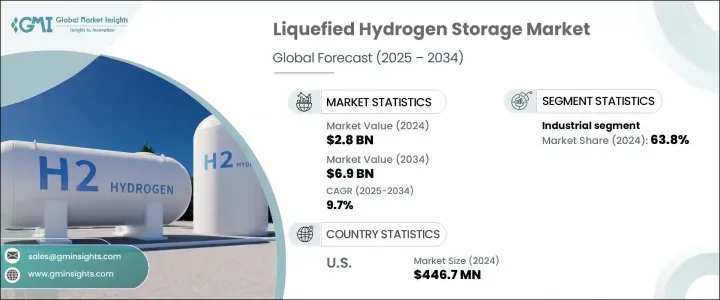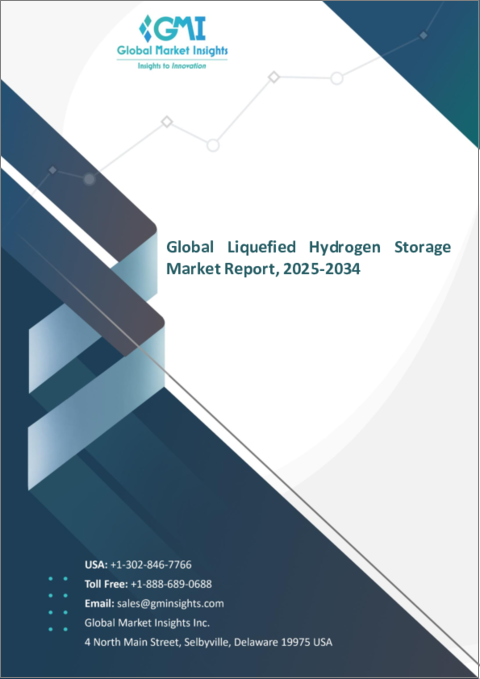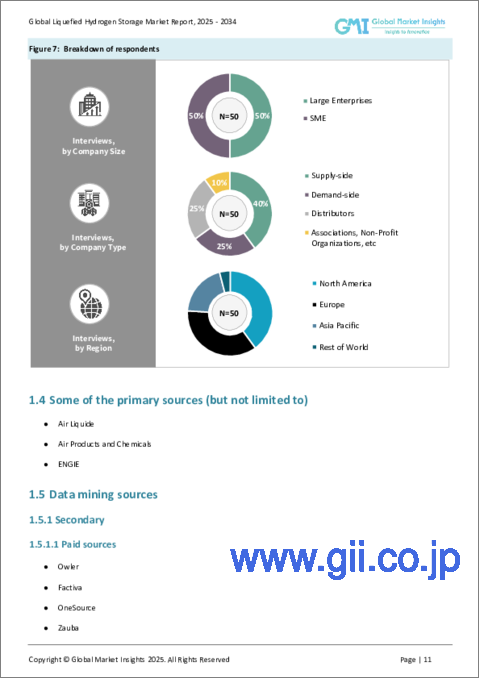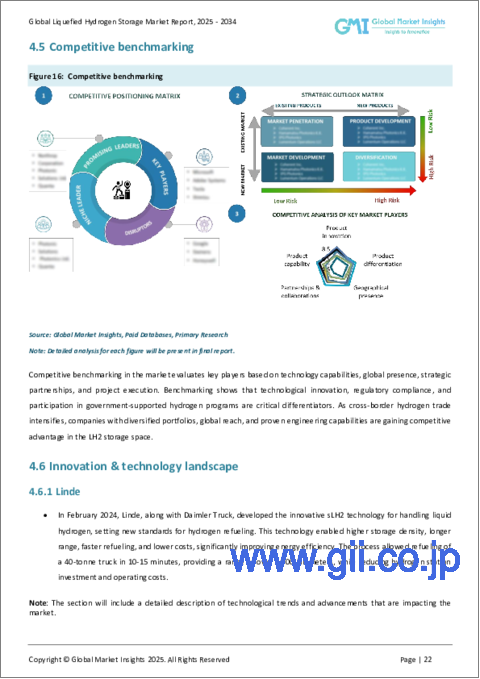|
|
市場調査レポート
商品コード
1741012
液化水素貯蔵市場の市場機会、成長促進要因、産業動向分析、2025年~2034年予測Liquefied Hydrogen Storage Market Opportunity, Growth Drivers, Industry Trend Analysis, and Forecast 2025 - 2034 |
||||||
カスタマイズ可能
|
|||||||
| 液化水素貯蔵市場の市場機会、成長促進要因、産業動向分析、2025年~2034年予測 |
|
出版日: 2025年04月17日
発行: Global Market Insights Inc.
ページ情報: 英文 125 Pages
納期: 2~3営業日
|
全表示
- 概要
- 目次
世界の液化水素貯蔵市場は、2024年に28億米ドルと評価され、よりクリーンな代替エネルギーへの世界のシフトの高まりを背景に、CAGR 9.7%で成長し、2034年には69億米ドルに達すると予測されています。
脱炭素化への取り組みが強化される中、液化水素は将来のエネルギー展望を再構築する重要なプレーヤーになりつつあります。政府、企業、消費者は、よりクリーンで効率的なソリューションを求め、水素技術にとって肥沃な土壌を作りつつあります。液化水素貯蔵はこの変革の中心にあり、再生可能エネルギー統合のためのスケーラブルで効率的、かつコスト効率の高いソリューションを提供しています。極低温技術、よりスマートな監視システム、コンパクトな設計におけるブレークスルーは、業界をより高い信頼性と手頃な価格へと押し上げています。余剰の再生可能エネルギーを水素として貯蔵し、需要がピークに達したときに利用する能力は、間欠性と送電網の安定性に関する重要な課題を解決しています。各国がインフラのアップグレードとエネルギー回復力に多額の投資を行う中、液化水素貯蔵は産業界全体で不可欠な存在となる態勢を整えています。民間の技術革新、公的資金、そして有利な規制の枠組みが融合し、前例のない成長機会が解き放たれつつあり、世界のエネルギー経済における極めて重要な転換の兆しを示しています。

液化水素への移行は、産業活動の枠を超え、モビリティ、エネルギー貯蔵、分散型発電へと大きく広がりつつあります。世界の政府の取り組みがこの勢いを加速させ、より環境に優しい技術を採用するための補助金や政策的インセンティブを提供しています。排ガス規制の強化は、輸送、発電、重工業の各分野で水素ソリューションの魅力を高めています。液化水素貯蔵は、これらの急速に進化するアプリケーションで強力な牽引力を得ており、世界の気候変動目標に沿った長期的で持続可能なエネルギー・ソリューションの舞台を整えています。
| 市場範囲 | |
|---|---|
| 開始年 | 2024 |
| 予測年 | 2025-2034 |
| 開始金額 | 28億米ドル |
| 予測金額 | 69億米ドル |
| CAGR | 9.7% |
化学、製油所、高熱製造などのセクターが、化石燃料からの脱却を目指して水素を統合しているため、2024年の産業セクターのシェアは63.8%と圧倒的です。液化水素はエネルギー密度が高いため、大規模貯蔵や高効率運転に理想的であり、依然として好ましい選択肢です。大容量で長距離のエネルギー貯蔵の必要性が高まっているため、液化水素はゼロ・エミッション性能に重点を置く輸送システムにとっても画期的な存在となっています。コンパクトな貯蔵フレームワークで長時間のエネルギー出力を実現する液化水素の能力は、産業界がスペースと効率の制約に取り組む上で極めて重要です。断続的な再生可能エネルギー源の拡大が加速する中、送電網の安定性を確保するために、需要と供給のバランスをとる水素の役割は、さらに重要になっています。
米国液化水素貯蔵2024年の水素市場は4億4,670万米ドルに達し、水素インフラ、特に燃料供給ステーションと大規模貯蔵プロジェクトへの旺盛な投資がその原動力となっています。高度な製造能力と電気自動車・水素自動車産業の成長が需要を後押ししています。エネルギー省をはじめとする連邦政府のイニシアティブは、将来に向けて貯蔵の拡張性と信頼性を高めるための研究開発努力を積極的に支援しています。
競争力を維持するため、FuelCell Energy、Cockerill Jingli、ITM Power、SSE、Air Products and Chemicals、ENGIE、Linde、McPhy Energy、Air Liquide、Gravitricity、GKN、Nelなどの企業は、技術革新と戦略的パートナーシップを強化しています。主な戦略には、生産能力の拡大、極低温断熱技術の進歩、長期的研究への投資、展開と製品多様化を迅速に進めるための共同事業の形成などがあります。政府支援プログラムへの積極的な参加も、これらの企業が新興市場で資金を確保し、先行者利益を築くのに役立っています。
目次
第1章 調査手法と範囲
第2章 エグゼクティブサマリー
第3章 業界考察
- エコシステム分析
- 貿易管理関税分析
- 貿易への影響
- 貿易量の混乱
- 報復措置
- 業界への影響
- 供給側の影響(原材料)
- 主要原材料の価格変動
- サプライチェーンの再構築
- 生産コストへの影響
- 需要側の影響(販売価格)
- 最終市場への価格伝達
- 市場シェアの動向
- 消費者の反応パターン
- 供給側の影響(原材料)
- 貿易への影響
- 規制情勢
- 業界への影響要因
- 促進要因
- 業界の潜在的リスク&課題
- 成長可能性分析
- ポーター分析
- PESTEL分析
第4章 競合情勢
- イントロダクション
- 戦略的展望
- イノベーションと持続可能性の情勢
第5章 市場規模・予測:用途別、2021-2034
- 主要動向
- 産業
- 交通機関
- 据置型
- その他
第6章 市場規模・予測:地域別、2021-2034
- 主要動向
- 北米
- 米国
- カナダ
- メキシコ
- 欧州
- ドイツ
- 英国
- フランス
- イタリア
- オランダ
- ロシア
- アジア太平洋地域
- 中国
- 日本
- インド
第7章 企業プロファイル
- Air Liquide
- Air Products and Chemicals
- Cockerill Jingli
- ENGIE
- FuelCell Energy
- GKN
- Gravitricity
- ITM Power
- Linde
- McPhy Energy
- Nel
- SSE
The Global Liquefied Hydrogen Storage Market was valued at USD 2.8 billion in 2024 and is estimated to grow at a CAGR of 9.7% to reach USD 6.9 billion by 2034, driven by the growing worldwide shift toward cleaner energy alternatives. As decarbonization efforts intensify, liquefied hydrogen is becoming a key player in reshaping the future energy landscape. Governments, corporations, and consumers are aligning to demand cleaner, more efficient solutions, creating fertile ground for hydrogen technologies. Liquefied hydrogen storage is at the heart of this transformation, providing a scalable, efficient, and cost-effective solution for renewable energy integration. Breakthroughs in cryogenic technologies, smarter monitoring systems, and compact designs are pushing the industry toward higher reliability and affordability. The ability to store excess renewable energy as hydrogen and utilize it when demand peaks is solving critical challenges related to intermittency and grid stability. As nations invest heavily in infrastructure upgrades and energy resilience, liquefied hydrogen storage is poised to become indispensable across industries. Private-sector innovation, public funding, and favorable regulatory frameworks are converging to unlock unprecedented growth opportunities, signaling a pivotal shift in the global energy economy.

The transition to liquefied hydrogen is extending beyond industrial operations and making strong inroads into mobility, energy storage, and distributed power generation. Worldwide government initiatives are accelerating the momentum, offering subsidies and policy incentives to adopt greener technologies. Tightening emission regulations are making hydrogen solutions increasingly attractive across transportation, power generation, and heavy industry. Liquefied hydrogen storage is gaining strong traction in these fast-evolving applications, setting the stage for long-term, sustainable energy solutions that align with global climate targets.
| Market Scope | |
|---|---|
| Start Year | 2024 |
| Forecast Year | 2025-2034 |
| Start Value | $2.8 Billion |
| Forecast Value | $6.9 Billion |
| CAGR | 9.7% |
The industrial sector accounted for a dominant 63.8% share in 2024 as sectors like chemicals, refineries, and high-heat manufacturing integrate hydrogen to phase out fossil-based fuels. Liquefied hydrogen remains the preferred choice due to its higher energy density, making it ideal for large-scale storage and high-efficiency operations. The growing need for high-capacity, long-range energy storage is also making liquefied hydrogen a game-changer for transportation systems focused on zero-emission performance. Its ability to deliver extended energy outputs within compact storage frameworks is critical as industries tackle space and efficiency constraints. As the expansion of intermittent renewable energy sources accelerates, hydrogen's role in balancing supply and demand is becoming even more vital to ensuring grid stability.
The United States Liquefied Hydrogen Storage Market reached USD 446.7 million in 2024, fueled by robust investment in hydrogen infrastructure, especially in fueling stations and large storage projects. Advanced manufacturing capabilities and the growing electric and hydrogen vehicle industries are propelling demand. Federal initiatives, including those led by the Department of Energy, are aggressively supporting R&D efforts to enhance storage scalability and reliability for the future.
To stay competitive, companies like FuelCell Energy, Cockerill Jingli, ITM Power, SSE, Air Products and Chemicals, ENGIE, Linde, McPhy Energy, Air Liquide, Gravitricity, GKN, and Nel are doubling down on innovation and strategic partnerships. Key strategies include expanding production capacities, advancing cryogenic insulation technologies, investing in long-term research, and forming collaborative ventures to fast-track deployment and product diversification. Active participation in government-backed programs is also helping these players secure funding and build early-mover advantages across emerging markets.
Table of Contents
Chapter 1 Methodology & Scope
- 1.1 Market definitions
- 1.2 Base estimates & calculations
- 1.3 Forecast calculation
- 1.4 Data sources
- 1.4.1 Primary
- 1.4.2 Secondary
- 1.4.2.1 Paid
- 1.4.2.2 Public
Chapter 2 Executive Summary
- 2.1 Industry synopsis, 2021 - 2034
Chapter 3 Industry Insights
- 3.1 Industry ecosystem analysis
- 3.2 Trade administration tariff analysis
- 3.2.1 Impact on trade
- 3.2.1.1 Trade volume disruptions
- 3.2.1.2 Retaliatory measures
- 3.2.2 Impact on the industry
- 3.2.2.1 Supply-side impact (raw materials)
- 3.2.2.1.1 Price volatility in key materials
- 3.2.2.1.2 Supply chain restructuring
- 3.2.2.1.3 Production cost implications
- 3.2.2.2 Demand-side impact (selling price)
- 3.2.2.2.1 Price transmission to end markets
- 3.2.2.2.2 Market share dynamics
- 3.2.2.2.3 Consumer response patterns
- 3.2.2.1 Supply-side impact (raw materials)
- 3.2.1 Impact on trade
- 3.3 Regulatory landscape
- 3.4 Industry impact forces
- 3.4.1 Growth drivers
- 3.4.2 Industry pitfalls & challenges
- 3.5 Growth potential analysis
- 3.6 Porter's analysis
- 3.6.1 Bargaining power of suppliers
- 3.6.2 Bargaining power of buyers
- 3.6.3 Threat of new entrants
- 3.6.4 Threat of substitutes
- 3.7 PESTEL analysis
Chapter 4 Competitive Landscape, 2024
- 4.1 Introduction
- 4.2 Strategic outlook
- 4.3 Innovation & sustainability landscape
Chapter 5 Market Size and Forecast, By Application, 2021 - 2034, (USD Million)
- 5.1 Key trends
- 5.2 Industrial
- 5.3 Transportation
- 5.4 Stationary
- 5.5 Others
Chapter 6 Market Size and Forecast, By Region, 2021 - 2034, (USD Million)
- 6.1 Key trends
- 6.2 North America
- 6.2.1 U.S.
- 6.2.2 Canada
- 6.2.3 Mexico
- 6.3 Europe
- 6.3.1 Germany
- 6.3.2 UK
- 6.3.3 France
- 6.3.4 Italy
- 6.3.5 Netherlands
- 6.3.6 Russia
- 6.4 Asia Pacific
- 6.4.1 China
- 6.4.2 Japan
- 6.4.3 India
Chapter 7 Company Profiles
- 7.1 Air Liquide
- 7.2 Air Products and Chemicals
- 7.3 Cockerill Jingli
- 7.4 ENGIE
- 7.5 FuelCell Energy
- 7.6 GKN
- 7.7 Gravitricity
- 7.8 ITM Power
- 7.9 Linde
- 7.10 McPhy Energy
- 7.11 Nel
- 7.12 SSE






